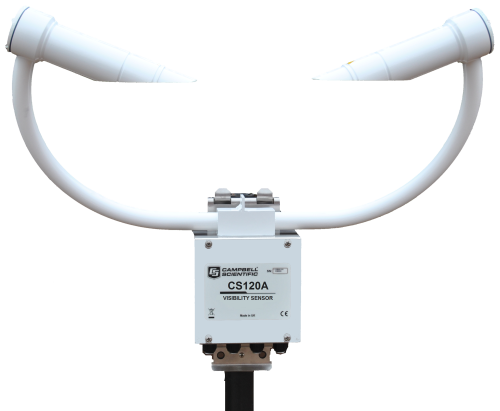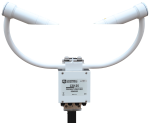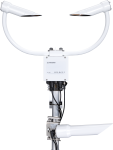






Überblick
Der CS120A ist ein Sichtweitensensor, der die Vorwärtsstreuung der Infrarotstrahlung misst. Er kann allein oder an einer Wetterstation betrieben werden und kommt für Luftfahrt, Verkehr und Forschung zum Einsatz. Die verwendete Messung der Vorwärtsstreuung ist etabliert und der Winkel von 42° gibt eine genaue Abschätzung der meteorologischen Sichtweite (M.O.R.) in Schnee und Nebel im Bereich 5 - 75000m (16,4 bis 246063 ft).
Für Anwendungen aus der Luftfahrt erfüllt der CS120A die Vorgaben der CAA (Civil aviation authority) und ICAA Richtlinien und entspricht oder übertrifft alle Spezifikationen und Empfehlungen (inklusive CAP437, CAP670 und CAP746).
Der Sensor ist vom DWD (Deutscher Wetterdienst) zum Betrieb nach 506/04 AVV zur Kennzeichnung von Luftfahrthindernissen anerkannt.
Lesen Sie mehrFunktionen und Vorteile
- High performance sensor at a competitive price
- Three year extended warranty available on this product
- Sensor design minimises airflow disruption at measurement volume
- Incorporates automatic dew and hood heaters for all-weather operation
- Simple field calibration using optional calibration kit
- Low power - suitable for remote application
- Automatic status check for faults or window contamination
- Made in UK
- Type certified for Aviation use by the German Meteorological Service, Deutscher Wetterdienst (DWD)
Bilder

Technische Beschreibung
Compared to many such sensors, the CS120A design means that visibility is being measured in a relatively clean space because the position of the heads and body minimize disturbance of the airflow at the measurement volume.
The CS120A uses continuous high-speed sampling, which improves the accuracy of the measurements taken during mixed weather such as rain and hail, while providing reliable readings during more stable events such as fog and mist. High-speed sampling also allows the sensor to better respond to suddenly changing conditions.
The CS120A has several design features that keep its optics clean. Downward-facing optics minimize dirt and snow buildup. Low-powered heaters prevent the formation of dew, and a higher-powered heater prevents the formation of ice.
The sensor is very power efficient, drawing just 3 W during normal operation including the dew heaters; power can be reduced further by reducing the sample rate and manual control of the heaters.
Two configurable alarm outputs are provided and, via relays, these can drive external warning systems such as lights and fog-horns. They can also be used to switch the intensity of wind turbine warning lights depending upon current visibility levels.
Spezifikationen
| Signal Type/Output | RS-232, RS-485 |
| Measurement Description | Meteorological Observable Range (MOR) |
| Maximum Reported Visibility | 75 km (46.6 mi) |
| Minimum Reported Visibility | 5 m (16.4 ft) |
| Accuracy |
|
| Resolution | 1 m (3.3 ft) |
| Mounting | Stainless-steel V-bolt bracket that attaches to a pole with a 32 to 52.5 mm (1.25 to 2 in.) outer diameter |
| Electronics Supply Voltage | 7 to 30 Vdc |
| Total Unit Power | < 3 W while sampling continuously (including dew heaters) |
| Standards | Frangible masts are available to customer requirements to meet ICAO recommendations (typically placing the sample volume at 2.5 m [8.2 ft]). |
| Sensor Dimensions | 540 x 640 x 246 mm (21.26 x 25.2 x 9.7 in.) including mount |
| Sensor Weight | ~3 kg (6.6 lb) depending on mounting system |
Optical/Pulse |
|
| LED Center Wavelength | 850 nm |
| LED Spectral Bandwidth | ±35 nm |
| Light Pulse Rate | 1 kHz |
Environmental |
|
| Operating Temperature Range | -25° to +60°C (standard) |
| Extended Operating Temperature Range | -40° to +70°C (This extended version is available as a special. Contact Campbell Scientific for more information.) |
| Operating Humidity Range | 0 to 100% |
| Sensor Sealing | Rated to IP66 |
| Wind Speed | Up to 60 m s-1 |
| Sensor Heater Threshold |
|
DSP & Dew Heaters |
|
| Power | 2 x 0.6 W (total of 1.4 W) for dew heater |
| Typical Current Consumption @ 12 Vdc |
|
Hood Heater |
|
| Supply Voltage | 24 V dc or ac |
| Power | 2 x 30 W (total of 60 W) |
Interface |
|
| Serial Interface | RS-232 or RS-485, 8 bit data bytes, 1 stop bit |
| Serial Data Rates | 1200 to 115,200 bps (38,400 bps default rate) |
Dokumente
Broschüren Produkte
Handbücher
Realisierte Projekte
Downloads
CR1000X CS120A example programs v.1 (2 KB) 18-03-2020
CR1000X programs that use the MSSET and MSGET commands.
CS125 and CS120A OS v.17 (555 KB) 08-06-2023
Campbell Scientific has introduced a new operating system, OS 17, for the CS120A visibility sensor and CS125 present weather sensor. It is backwards compatible and is easily installed on all CS120A and CS125 sensors (but not older CS120 sensors). OS 17 is available free of charge and can be downloaded here or supplied by email on request.
Upgrade to OS 17 is recommended.
Anwendungsbeispiele
AUDIMOBIL recently installed an Automatic Weather Station in a Portuguese Military Air Base, to support......lesen Sie mehr


